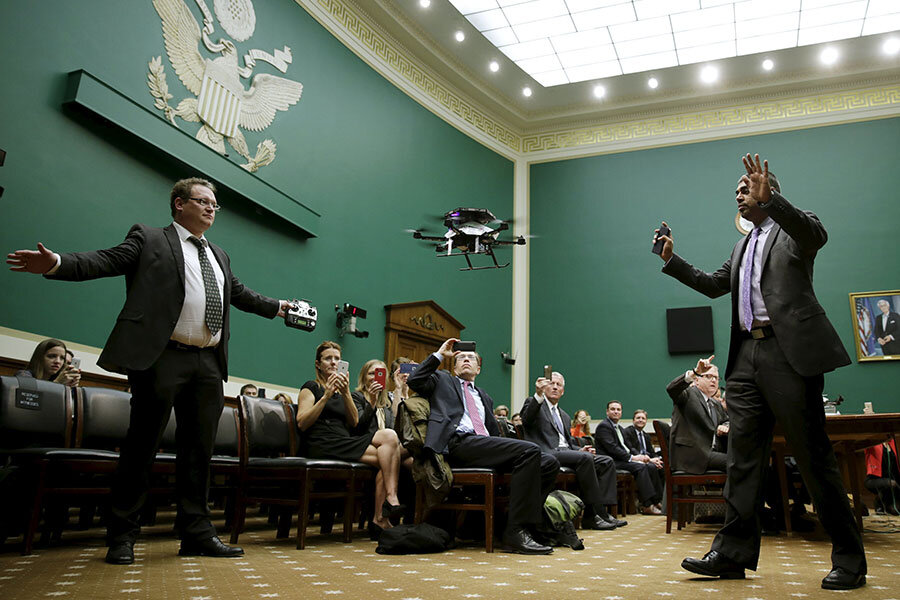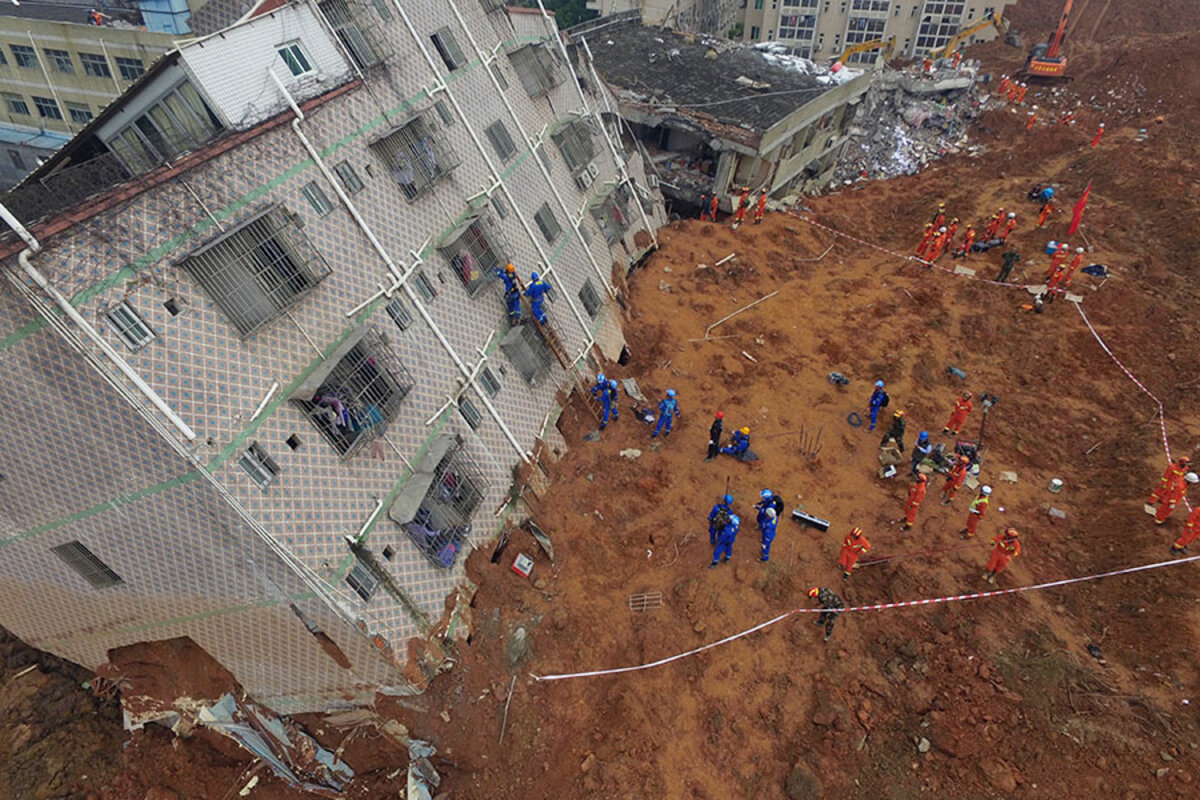Meet the people who think more drones are a really good idea
Loading...
| Wellesley, Mass.
When real estate photographer Tom Sheehan purchased his DJI Phantom 3 drone over the summer, he had hoped to use the quadcopter to upgrade his business.
“It was the logical next step,” says Mr. Sheehan, who went all-digital with his Norwell, Mass., photography venture in 2005. He envisioned taking bird’s-eye pictures of homes by the coast, using the drone to snap views of the water.
But Sheehan quickly discovered that obstacles stood in the way of flying a drone, particularly for commercial purposes. Among other things, current Federal Aviation Administration (FAA) regulations require him to not only obtain an exemption so he can use the drone for business – a process that can take months and cost hundreds, if not thousands, of dollars in consultation fees – but also hire a licensed pilot to fly the drone for him.
“It was discouraging,” Sheehan says. “It’s a big pain in the neck.”
To many in the industry, Sheehan’s story sounds familiar. As more drones, or unmanned aircraft systems (UAS), take to the skies, experts are concerned that policy and public awareness have not kept up with the pace of technology. Existing regulations, they say, have yet to strike a balance between enabling the industry to thrive and addressing the technology’s potential consequences.
“Right now it’s kind of a ‘wild west’ in regulation. The technology has moved much more quickly than policy has,” says Lisa Ellman, a public policy lawyer and co-chair of the UAS group at international law firm Hogan Lovells.
Without policies that encourage enterprise, she says, the government risks stifling innovation, especially among smaller commercial operators such as Sheehan and university researchers at the cutting edge of technology. At the same time, failing to develop – and disseminate – rules that address issues such as privacy and safety could lead to the kind of “horror stories” that give drones a bad name.
“[T]here’s always a lot of concern [around new technology], and some of it is very well-founded,” Ms. Ellman says. “We must craft rules that enable the good and prevent the bad. The industry has to win the public’s trust.”
Perception problems
Tuesday night in Italy, a drone carrying a camera crashed on a ski slope just behind a racer as he was making a slalom run. On Wednesday the International Ski Federation (FIS) banned drones from its World Cup races.
They will be prohibited "as long as I am responsible .... because they are a bad thing for safety," FIS men's race director Markus Waldner told The Associated Press.
The story is one of a series of highly-publicized incidents – from one recreational quadcopter crashing on the presidential lawn in January to another getting in the way of firefighting efforts in the West Coast. FAA reports about the rising number of UAS sightings and “close calls” with aircraft, along with longstanding associations with military strikes in the Middle East, have done little to improve the drone’s reputation.
“The general public, when they think of drones, they think of Predators in Afghanistan,” says Mykel Kochenderfer, an assistant professor of aeronautics and astronautics at Stanford University. “They don’t really think of it as technology that can save lives.”
Drone enthusiasts have tried to counter drones’ bad reputation with information: The actual number of near misses that involved drone hobbyists was in the dozens, not hundreds, according to an analysis of FAA data by the Academy of Model Aeronautics (AMA), a nonprofit model aviation association in Muncie, Ind.
Safety “is a really big issue,” Rich Hanson, AMA’s director of government and regulatory affairs, told the Monitor last month. But “we believe that to a certain extent, [the figures] have been a bit overstated.”
Still, the abiding view is that drones pose a real safety and privacy risk. In response, some lawmakers are fighting to curb UAS use and close what they say is a gap between comparatively strong FAA regulations for commercial drones and weak rules for hobbyists.
“Consumer drones are a new technology. They can fly thousands of feet in the air and jeopardize air travel, but the FAA can only regulate them if they are used for commercial purposes,” said Sen. Dianne Feinstein (D) of California in June. “That loophole must be closed.”
For businesses and beyond
In the commercial realm, many are willing to go through the existing regulatory process while waiting for the FAA to hammer out a more flexible set of rules. But others would rather forge ahead.
Until the FAA granted Amazon permission to start testing drones in the US, for instance, the online retailer had conducted experiments in Canada, where the regulations are more relaxed. Google, too, conducted test flights in Australia.
“Other countries are ahead of us in terms of regulation and our companies are moving overseas to push their innovation,” says Ellman of Hogan Lovells.
For some smaller businesses, going international is hardly an option.
“It’s only now becoming apparent what hoops we have to jump through” to fly drones for profit, says Tim Palmioli, business manager for Atwater Studios, a commercial videography and photography company in Springfield, Mass. “It’s a huge concern.”
The studio bought its Inspire 1 drone in the past year and started taking photos and video with the device about eight months ago, Mr. Palmioli says.
At the time, Atwater had not yet acquired the document the FAA requires of businesses to legally fly drones for commercial use. Nor had the company hired a licensed pilot to fly the device.
Palmioli insists the studio was careful – at least three people were present whenever they used the device for jobs, and the drone was always kept within line of sight, he says. He quips, “It’s better to ask for forgiveness than for permission, sometimes.”
There’s more at stake than drones’ potential to take pictures or deliver packages.
Under FAA rules, public universities can obtain a waiver that allows them to operate drones at or below 200 feet – as long as the devices weigh less than 55 pounds and fly only during daylight hours, within the operator’s visual line of sight, and at certain distances from airports. But private universities are considered commercial operators, which means the restrictions are more stringent.
Chris Roosevelt, an associate professor of archeology at Boston University, employs drones to study excavated ruins in Turkey. We’re “effectively hamstrung from offering current students, undergraduate and graduate, the proper training they need to even get their feet wet much less master one of the cutting-edge technologies,” he told The Boston Globe last year.
Looking ahead
One gray afternoon in late October, a small group of men gather at an empty lawn at Babson College, a private business school in Wellesley, Mass. Their goal: To get a taste of piloting an actual drone and learn the rules around flying the devices.
Conducting the class are two men from DARTdrones Flight Academy, a Woburn, Mass., organization that provides education and training to would-be drone users and helps commercial entities apply for and obtain exemptions to fly drones. Through education, the group seeks to change the way the public views drones.
“What’s making it in the news is all the negative stuff,” says Jon Burton, DART’s director of operations. A few feet away, a white DJI Phantom 3 whirs to life as Mr. Burton’s colleague, licensed aviator Collin Murray, showed the class how to man the device’s controls.
“People’s concerns [about drone safety] are genuine, but the more they get educated, the more understanding they have of what drones can do,” Mr. Burton says.
The FAA in October announced the creation of a drone registry in order to help recreational drone fliers comply with existing rules, and make it easier for officials to identify which drones are flouting the rules. The registry went live Monday in the middle of a holiday season when drone sales are expected to reach 700,000 units.
Industry stakeholders met the plan with cautious optimism.
Despite the challenges facing drones, excitement about the industry remains high.
“We like drones for dirty, dreary, and dangerous tasks: cell tower inspections, crop inspections, disaster response,” Ellman says. “Drones are going to be able to help every facet of our lives – inspect our roofs, bring our news. They are going to affect our lives in ways we haven’t imagined.”
Commercial operators in particular are waiting for the FAA’s final set of rules, which many anticipate will include guidelines for a drone pilot certification test – an exam that would allow anyone who passes to fly a drone for profit and do away with the need to hire a licensed aviation pilot. The rules are due in 2016.
At the DART class at Babson College, Sheehan, the photographer from Norwell, says flying a drone with his own two hands has convinced him further of the technology’s promise. He plans start using his own Phantom for business by spring.
“I hope they have all this licensing taken care of by then,” he says.
In the meantime, he adds, “There’s a lot of work, but… I think it’s worth it.”








